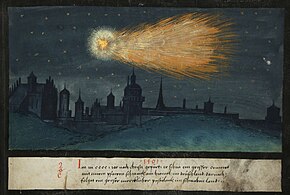 The comet in the Augsburg Book of Miracles, ca 1552 The comet in the Augsburg Book of Miracles, ca 1552 | |
| Discovery | |
|---|---|
| Discovery date | 8 February 1402 |
| Orbital characteristics | |
| Epoch | 21 March 1402 |
| Perihelion | 0.38 AU |
| Eccentricity | ~1.000 (assumed) |
| Inclination | 55.00° |
| Longitude of ascending node | 126.00° |
| Argument of periapsis | 91.00° |
| Last perihelion | 21 March 1402 |
| Comet total magnitude (M1) | 0–1 |
The Great Comet of 1402 (designated as C/1402 D1 in modern nomenclature) was a bright comet seen between February and April 1402. The comet was reported to be visible in daylight for 8 days, the longest recorded for a comet. The comet is mentioned in many chronicles, with most of them placing the comet in 1402, but it has been suggested that comets mentioned to be seen in 1401 and 1403 are in reality accounts with chronological errors of the great comet of 1402.
Accounts
In Tractatus de Cometis, which is the most extensive account of the comet, Jacobus Angelus mentions that the comet was first seen in early February. In mid March he mentions that the tail of the comet was about 45 degrees long and shaped like an inverted pyramid that became diffuse. He last saw the comet on 26 or 27 March, mentioning "in the east before sunrise its vestiges appeared, because I saw three long and very thick hairs", indicating the presence of striae, while one more was visible after sunset, which could be the ion tail.
The Italian chronicle Annales Forolivienses, from 1473, mentions the comet was east of Aries at the end of February and early March and grew brighter and during mid-March it mentions that the comet was visible in daylight preceding the Sun. The comet is also mentioned in many other chronicles, including Russian and Muslim ones, which mention it was visible from February to April and that it was large and bright.
The most extensive account from Asian sources is the Korean text T'aejong Sillok, which mentions that the comet was first noticed on 20 February as a broom star with a tail 5–6° long in the area of Khuei (covers parts of Andromeda and Pisces). Two days later the tail was 10 degrees long. The comet was also seen on 8 March and last seen on 19 March. The comet is also mentioned in a Japanese text from 1715 but it isn't mentioned by the Chinese.
In his book Historia Byzantina (1462), historian Doukas mentions that a bright comet was seen during the Battle of Ankara in July 1402 with the description implying it was visible during daytime, and it remained visible until the autumnal equinox. However, no other source mentions that comet, while the description also appears exaggerated. David Seargent suggests that he actually mentions the comet seen in early in 1402 but displaced it chronologically to coincide with the battle.
Orbit
John Russell Hind calculated in 1877 an approximate orbit based on the descriptions, with a perihelion distance of 0.38 AU, while the closest approach to Earth was on February 20 at a distance of 0.71 AU.
References
- "C/1402 D1 – JPL Small-Body Database Browser". ssd.jpl.nasa.gov. Jet Propulsion Laboratory. Retrieved 9 August 2023.
- ^ Kronk, Gary W. (1999). Cometography: 1800-1899. Cambridge University Press. pp. 260–263. ISBN 978-0-521-58504-0.
- ^ Helmolt, Dr. (1892). "Der Comet vom Frühjahr 1402" [The Comet of Spring 1402]. Astronomische Nachrichten. 129 (20): 301–306. Bibcode:1892AN....129..301H. doi:10.1002/asna.18921292003.
- ^ Seargent, David A. J. (2009). The Greatest Comets in History: Broom Stars and Celestial Scimitars. New York, USA: Springer. pp. 99–102. doi:10.1007/978-0-387-09513-4. ISBN 978-0-387-09512-7.

